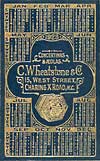Posted 15 August 2005
The Life and Times of the Concertina:
the adoption and usage of a novel musical instrument
with particular reference to Scotland
Stuart Eydmann
Notes for the web edition
This dissertation was examined in late 1994 and approved by the Open University examination board in
early 1995. At its heart, are field recordings which were undertaken during the 1980s of many of
the older (i.e. over 65 years of age) concertina players active in Scotland at the time. Only a
fragment of the oral and musical testimony of these players is presented here and it is my intention
to make more of this material available through this site in due course. I have also accumulated
an archive of related photographic and ephemeral material that I would also like to share in time.
The field recordings are to be transferred to the School of Scottish Studies at the University of
Edinburgh in the near future although it is also my hope to make selected pieces available, perhaps as MP3 files.
It has been my ambition for some time to publish the study on the web but this has been delayed
due to lack of time, the technical difficulties of converting the material to electronic format,
a desire to protect the featured musicians and their families and some reluctance to expose my
meagre work to the general public. However, reading it during the preparation for the online
edition I am confident that, on the whole, it has stood the test of time and still provides a
reasonably accurate and accessible survey of the history of the instrument that also helps to
make a small contribution to the grossly under researched area of Scottish music studies. In
undertaking the work I did not have the advantage of access to the Internet and the treasures
which it offers, nor was I aware of the excellent work of Professor Allan Atlas of New York so
inevitably there are gaps in the knowledge it contains. Despite this I feel that my positioning
of the instrument in its broader historical and contexts remains a strength which gives the thesis
particular value. It is hoped, therefore, that this work might be the model for other studies of
other instruments.
The study merely scrapes the surface of some areas that would be worthy of detailed study by
others. In particular I would single out the concertina in the Salvation Army
(Chapters 8 and 9)
and recommend the organisation's journals (such as The Musician) for their wealth of articles
on the instrument and its players.
Chapter 11 on the folk music revival (where I came in!) has
been expanded in a paper published as "The Concertina as an Emblem of the Folk Music Revival in the British Isles,"
British Journal of Ethnomusicology 4 (1995), 41–49, but the area is ripe for more detailed research,
particularly as so many key players are still with us.
Much has, of course, come to light since I undertook my research. For instance, other articles
in this web site contain recently discovered material on the musical activities of Bridgman,
the Lachenals and Maccann in Scotland and I am sure there is much more to come. Since 1995
I have kept a file of additional information on the concertina in Scotland and unless specific
items are worthy of publishing in their own right I intend to prepare an update chapter of snippets.
The academic version carried the following acknowledgements:
I am grateful to Norman Chalmers and Ann Ward for their encouragement of my early research into
the concertina in Scotland and to William Grant and Sons Ltd. for their sponsorship of my preliminary
programme of field recording through the assistance of a Glenfiddich Living Scotland Award. The support
of Professor Ruth Finnegan of the Open University and Dr. Peter Cooke of Edinburgh University helped me
put my work on an academic footing and I am indebted to the Research Degrees Committee of the Open University
for subsequently offering registration as a part time external student. My supervisors Dr. Peter Cooke
(external) and Dr. Richard Middleton (internal) have skilfully and tactfully steered my work while
freely offering expertise, experience and knowledge as required.
The efficiency and patience of staff in a number of institutions has been crucial to my research,
including those of the National Library of Scotland (in particular Ruzena Wood and Roger Duce of
the Music Library), The British Library, The Reid Music Library and the Main Library of Edinburgh
University, the Central and Music Libraries of The City of Edinburgh District Council, The Mitchell Library,
Glasgow, The National Sound Archive, London, B.B.C. Radio Scotland and The Irish Traditional Music Archive,
Dublin. The Inter-Library Loan Service has been invaluable. Iris Bishop, Librarian of the International
Concertina Association must be mentioned for her help in providing access to the organisation’s archive.
There are many others who should have been mentioned for their assistance and encouragement
including Jo Miller, Steve Sutcliffe, Peggy Duesenberry, Frank Bruce and, of course,
Márín, Maeve and Calum Eydmann who allowed me to indulge in this project.
Finally, this edition could not have been possible without the assistance of Robert Gaskins
who managed to prod me into action and was able to address all technical issues with ease
and no little style. The www.concertina.com web site is a true example of the democratisation
of information and one with which I am delighted to be associated.
Stuart Eydmann
Edinburgh, July 2005
Note: the last item in the list below is a link to the
full document in one file,
containing all the sections listed, to read or download.
-
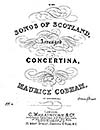 Chapter 1: Introduction
Chapter 1: Introduction
-
by Stuart Eydmann
-
The dissertation in context including some background to the project,
its relevance to Scottish music studies and the methodology adopted.
In particular it considers options for musical instrument based studies
which can accommodate economic and social considerations alongside the
musical and organological aspects.
Pages 1–22.
-
Posted 15 June 2005
-
» read full chapter in pdf
-
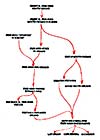 Chapter 2: The Modern Free-Reed Instrument in Context
Chapter 2: The Modern Free-Reed Instrument in Context
-
by Stuart Eydmann
-
A brief introduction to the free reed instruments of the world and in
particular the experimental development and subsequent incorporation of
the means of sound making into viable musical instruments with a commercial
potential.
Pages 23–37.
-
Posted 15 June 2005
-
» read full chapter in pdf
-
 Chapter 3: The Invention of the Concertina
Chapter 3: The Invention of the Concertina
-
by Stuart Eydmann
-
Following on from the previous chapter this looks at the arrival of the
concertina on the musical scene. Attention is paid to the motivation behind
its creation and design including, of course, the central role of Charles
Wheatstone.
Pages 38–58.
-
Posted 15 June 2005
-
» read full chapter in pdf
-
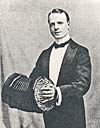 Chapter 4: Concertinists, Concerts and Composers
Chapter 4: Concertinists, Concerts and Composers
-
by Stuart Eydmann
-
A look at the principal early champions of the concertina and their musical activities.
William Bridgman of Edinburgh is considered in some detail.
Pages 59–78.
-
Posted 15 June 2005
-
» read full chapter in pdf
-
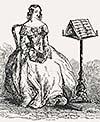 Chapter 5: The English Concertina: Instrument of the Victorian Middle Classes
Chapter 5: The English Concertina: Instrument of the Victorian Middle Classes
-
by Stuart Eydmann
-
A discussion of how the English concertina was taken up by middle class
amateur musicians and the development of an extensive infrastructure of
teachers, composers, publishers, manufacturers and retailers.
Pages 79–109.
-
Posted 15 June 2005
-
» read full chapter in pdf
-
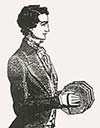 Chapter 6: The Anglo-German Concertina: Product Diversification in an Expanding Market
Chapter 6: The Anglo-German Concertina: Product Diversification in an Expanding Market
-
by Stuart Eydmann
-
How the Anglo-German concertina found favour with the working classes of the
nineteenth century including its popularity in Scotland in the period between
1850 and 1875 after which the button accordion became a more attractive option.
Consideration is given to the implications of the performance of Scottish
traditional music on the instrument.
Pages 110–150.
-
Posted 15 June 2005
-
» read full chapter in pdf
-
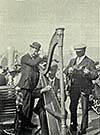 Chapter 7: The Concertina in the Music Hall and Variety Theatre
Chapter 7: The Concertina in the Music Hall and Variety Theatre
-
by Stuart Eydmann
-
Consideration of the lives and music of the second wave of professional concertinists—those
who made their living within the flourishing music hall and variety theatre circuit in Scotland
and beyond.
Pages 151–193.
-
Posted 15 June 2005
-
» read full chapter in pdf
-
 Chapter 8: Concertina Bands
Chapter 8: Concertina Bands
-
by Stuart Eydmann
-
The concertina band movement which developed in parallel with the brass band
and other communal music making activities in the late nineteenth and early
twentieth centuries. Contains examples of repertory and musical arrangements.
Pages 194–211.
-
Posted 15 June 2005
-
» read full chapter in pdf
-
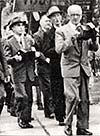 Chapter 9: The Concertina as an Instrument of Sacred Music
Chapter 9: The Concertina as an Instrument of Sacred Music
-
by Stuart Eydmann
-
How the concertina was adopted and used by the evangelical groups which came
to prominence in the British Isles from the 1880s onwards. A number of key
musicians are considered in some detail.
Pages 212–243.
-
Posted 15 June 2005
-
» read full chapter in pdf
-
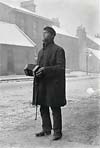 Chapter 10: Working Class Adoption of the English Concertina in Scotland 1900-1945
Chapter 10: Working Class Adoption of the English Concertina in Scotland 1900-1945
-
by Stuart Eydmann
-
An in-depth look at the amateur use of the concertina in urban Scotland, particular
attention to the inter-war period when it was particularly popular in Glasgow. Contains
musical transcriptions, photographs and oral testimony from a number of
important players who are representative of the period.
Pages 244–283.
-
Posted 15 June 2005
-
» read full chapter in pdf
-
 Chapter 11: Twentieth Century Revivals
Chapter 11: Twentieth Century Revivals
-
by Stuart Eydmann
-
How the concertina enjoyed a flourishing of interest through the activities of
the International Concertina Association and how, around the same time, the instrument
was "rediscovered" by the folk music revival.
Pages 284–317.
-
Posted 15 June 2005
-
» read full chapter in pdf
-
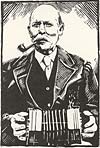 Chapter 12: Current Developments
Chapter 12: Current Developments
-
by Stuart Eydmann
-
A 1994 snapshot of the current use of the concertina with some discussion of
how its role might develop in the future.
Pages 318–340.
-
Posted 15 June 2005
-
» read full chapter in pdf
-
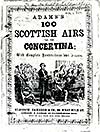 Bibliography
Bibliography
-
by Stuart Eydmann
-
Comprehensive bibliography, over 400 items.
Pages 341–365.
-
Posted 15 June 2005
-
» read full chapter in pdf
Read or Download the Whole Document in a Single File
-
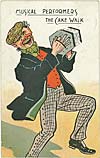 The Life and Times of the Concertina:
The Life and Times of the Concertina:
the adoption and usage of a novel musical instrument
with particular reference to Scotland
-
by Stuart Eydmann
-
The entire dissertation as a single PDF file.
Includes all 13 sections above, in order. Size is about 25 megabytes.
Click on the title or picture to open the document in PDF, or
right-click and choose “Save Target As …”
to save a personal copy of the entire file to your computer.
365 pages.
-
Posted 15 June 2005
-
» read full document in pdf (or right-click to download)
Author
Stuart Eydmann
(
)
was born and educated in Fife. Since graduating from the
Glasgow School of Art in 1975 he has pursued a career in heritage
conservation. In 1987 he received a Glenfiddich Living Scotland Award for
his oral history of the free-reed instruments and in 1995 gained a PhD from
the Open University for his thesis on the concertina and its players in
Scotland. He has taught history of popular and traditional music with the
Open University and the the Royal Scottish Academy of Music and Drama. As a
fiddle and concertina player he performs and records with the Scottish
traditional music ensemble the Whistlebinkies.
Have feedback on this article?
Send it to the author.
Reprinted from the Concertina Library
http://www.concertina.com
© Copyright 1995– by Stuart Eydmann
|
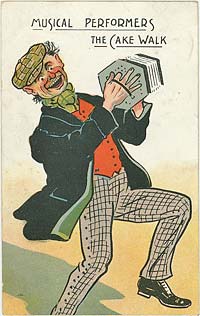
Picture postcard,
circa 1904
Contents
© 1994–2005 Stuart Eydmann.
Links to related documents
-
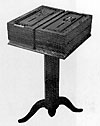 The Wheatstone English Concertina
The Wheatstone English Concertina
- by Neil Wayne
-
Survey article covering the Wheatstone English Concertina, the only
published source for much of Neil Wayne's path-breaking research.
As published in The Galpin Society Journal 44 (1991), 117-149. (The
online version does not yet perfectly match the printed version.)
- Posted 01 January 2005
-
» go to website
-
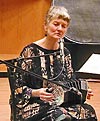 The concertina as an emblem
of the folk music revival
in the British Isles
The concertina as an emblem
of the folk music revival
in the British Isles
- by Stuart Eydmann
-
The post-war folk and traditional music revival in the British Isles was a complex
phenomenon which involved more than just the simple rediscovery and promotion of
neglected music and song. The ideology of key individuals was important in
determining the scope and subsequent diction of the revival including the sources of
the revived repertory and how it should be re-packaged. The selection and use of
appropriate musical instruments was a major issue and, for a time at least, the
concertina family was endorsed by the revivalists to the extent that it could act as a
symbol of the revival itself. This paper identifies and discusses the processes involved.
First published in
British Journal of Ethnomusicology,
vol. 4 (1995), pp. 41–49.
- Posted 15 August 2005
- » read full document
-
 Historic Concertina Patents
Historic Concertina Patents
-
Directory
-
A portfolio of full copies of
nine historic concertina patents. Includes the
early Wheatstone English patents, Maccann's Duet patent, Jones's Anglo patent,
the Crane Duet patent, Kaspar Wicki's patent for the Wicki-Hayden system, and Brian
Hayden's much later patent for the same system. Includes:
C. Wheatstone 1829; C. Wheatstone 1844; Wm. Wheatstone 1861; Maccann 1884;
Jones 1885; Alsepti and Ballinger 1885; Butterfield 1896; Wicki 1896; Hayden 1986.
None of these patents has any current force, all have either lapsed or been abandoned.
-
Posted 15 December 2004
-
» go to directory
-
 Historic Concertina Makers
Historic Concertina Makers
-
Directory
-
Concertina Library directory of all information on this website about historic
concertina makers, so far including C. Wheatstone & Co., Lachenal & Co.,
C. Jeffries Maker, George Jones & Sons, H. Crabb and Son.
-
Posted 01 January 2005
-
» go to directory
-
 Concertina Pricelists
Concertina Pricelists
- collected by Chris Algar
-
A unique collection of nearly 40 pricelists for vintage concertinas,
mostly found in old concertina cases. From internal evidence it is
possible to date the Wheatstone pricelists with more or less accuracy, but the Lachenal pricelists
and others from dealers still have some uncertainty in dates.
- Posted 07 March 2005
- » go to directory
-
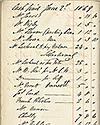 Wheatstone Concertina Ledgers
Wheatstone Concertina Ledgers
-
Directory
-
Historical business records of C. Wheatstone & Co. from
the Horniman Museum in London. Earlier ledgers from the Wayne Archives
contain company sales records from the late 1830s to the 1860s
along with production records from the 1860s to the 1890s and some
early records of wages and other payments. Later ledgers from the Dickinson Archives
contain production records from 1910 to 1974. All surviving ledgers
have been digitized (some 2,300 pages in total) and made available free on the web for
private research.
The same material is also available to buy on an inexpensive CD.
Includes an introduction to the project by Margaret Birley, Keeper of Musical Instruments at
the Horniman Museum, and an article by Robert Gaskins describing in detail how the ledgers
were digitized.
-
Posted 15 June 2003; Updated 15 June 2005
-
» go to directory
-
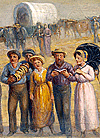 A Brief History of the Anglo Concertina in the United States
A Brief History of the Anglo Concertina in the United States
-
by Dan Worrall
-
In the United States the Anglo-German concertina was very popular during the middle and late
nineteenth century, but by the early twentieth century it had all but vanished from American popular
culture, becoming only a Hollywood symbol of “the old days”.
After the revival of interest in traditional music and in concertinas from the 1960s the Anglo has
once again had some popularity in the United States, but without connection to any tradition of its
earlier widespread use in America. This paper attempts to reconstruct a basic history
of the Anglo concertina in the U.S. by using nineteenth-century tutors, newspaper mentions,
anecdotes from family histories, and archival photographs.
Topics discussed include the early use of German concertinas in the Eastern U.S.,
the use of Anglo concertinas by Mormon and other western pioneers, use during the War Between the States,
use by African-Americans, use in nautical contexts, use by immigrant and other ethnic groups, and
use by the American branch of the Salvation Army. Some previously unpublished photographs are included.
-
Posted 15 April 2007
- » read full article
|






















